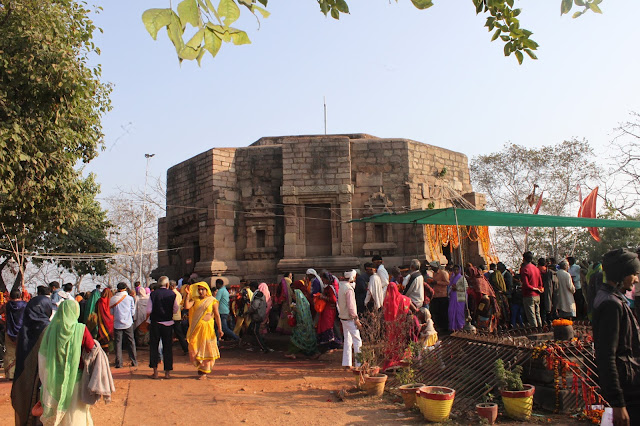Mundeshvari – History, Archaeology, Devotion . . .
Mundeshvari temple: History in every stone
An edited version of this
piece has been published in the Friday
Review.
Many thanks to colleagues and friends together on this trip, Fiona Buckee for sharing her paper and the team at The Hindu.
Mundeshvari Temple is considered the oldest functional temple in the country - I came across this clichéd sounding line multiple times. And questions arose. How old is it then? Is it older than Banaras and its temples? Banaras with all its history, mythology and umpteen temples. Few more questions arose and then I forgot all of them. Mundeshvari is located in Bhabua - 100 kms from Banaras.
I then landed upon the temple again in Saba Dewan’s classic Tawaifnama where she writes: ‘Some recent scholars are of the opinion that the goddess installed in the Mundesvari temple might well have been a deity worshipped originally by the aboriginal population described in the Vedic and post-Vedic texts as asura and daitya. In the long-drawn-out struggles between the forces of invading Brahmanism and the indigenous population of the Kaimur area, the goddess seems to have been usurped and made part of the Hindu pantheon’.
Together with 2 colleagues I then planned a trip from Banaras. We crossed over into Bihar and passed underneath a huge gate bearing the name of the temple. At the foot of the hill atop which the temple stands we saw people. Many people. Their spirits festive and their joyousness infectious. Some of them in colourful clothes, some arriving on tractors, some drying clothes, some at the stalls and some just there. Many of them were singing. Some had returned from the shrine, others were on their way up the hill. Atop the hill (the temple’s website lists its height at 182.8m) our joy continued as we came across multiple species of trees including Arjun, Peepal, Chilbil (Indian Elm), Semal (Silk Cotton) and Bael (Wood Apple). Music and trees are deep-rooted in our temples!
Fiona Buckee in her paper, The Curious Case of the Octagonal Temple: An architectural analysis and revised history of the Temples of Mundesvari Hill, 2020, describes the temple thus, ‘It is a sandstone Shiva temple built to an octagonal plan, with four doorways opening out in the cardinal directions and large central niches flanked by smaller side niches on each of the interceding walls. It lacks a spire’. She adds that it is ‘unusually broad, stretching 14m across from door to opposite door, which, combined with its truncated roof and heavy base mouldings, gives it a low-lying, heavy-set appearance’.
Archaeological remains are scattered all around the temple. I walked around, trying to absorb history literally lying around me, and wondered if more temples existed earlier on the hill-top. I then came across a signage that talked of them thus, ‘The large number of loose sculptures and architectural members scattered around the temple are perhaps part of the Sikhara and the Mandapas of the temple which collapsed long ago’.
Most people around appeared to be locals. Some were anxious to get inside the temple - there was a queue. While, a handful found quiet amidst the stones and prayed. There are deities installed in the open as well. This temple is well known for its offering of goats. We were told that the goats brought to the temple are not killed – they get unconscious for some time and then leave. Some refer to it as a miracle, others as symbolic sacrifice. We also saw pebbles and small stones placed atop one another. While the goat numbers we could count on our fingers these representative homes were numerous. We also saw people make them together. They sought blessings of the lord for homes they would build in the time to come.
The temple like many of our older places of worship presents an endearing view of the landscape around. I tried to imagine the landscape as it would have been when during Huen Tsang’s time. The temple website also states that Huen Tsang, 636 – 638 AD, wrote about the temple thus, ‘shrine atop a hilltop flashing light, at about a distance of 200 lee southwest to Patna’. Or when Thomas and William Daniell, who gave us first published records of the site, came during 1790. Enticed, together with colleagues, I walked around. We reached a not-in-use interpretation centre, saw a brick kiln in distance and also came across what appeared like sloth bear poop.
Back to the age. Buckee’s paper proposes that, ‘rather than being seventh century, the octagonal shrine was built about a millennia later, in the sixteenth–seventeenth century, incorporating doorways and mouldings salvaged from the ruins of the seventh century temples that once graced the hilltop’.‘This in no way denigrates the Importance and sanctity of the monument or the site’ it rather identifies, she adds, ‘yet another milestone on the long timeline of architectural patronage and worship at this remarkable hilltop’. The debate is on.
The people, however, like they have been doing for centuries, continue to visit this hill-top temple.



Comments
Post a Comment